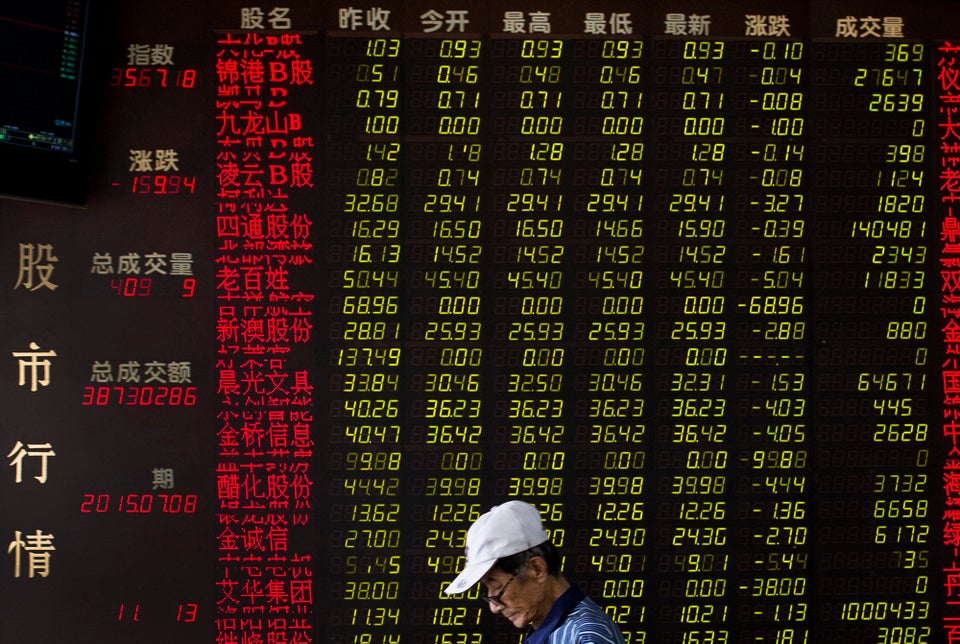
BEIJING -- Over recent months China's stock market drama has joined the Greek debt crisis in grabbing global headlines. If a stock market crash destabilizes China's enormous financial system and harms the second largest economy in the world, it could send massive shockwaves throughout global markets, a scenario clearly far more threatening than a messy Grexit.
The Chinese authorities certainly have taken no chance of that happening.
Ever since the market slide started in early June, the People's Bank of China, as well as the China Securities Regulatory Commission, have introduced a series of measures to stabilize the panicky market. The policy responses are unprecedented in scope.
In a bid to forestall any liquidity shortfalls, not only have standard monetary easing measures such as interest rate cuts and reduction of bank reserve requirement ratios been put in place, but more drastic steps have been taken as well.
Trading was halted, with nearly half of the 2,700 publicly listed companies having stopped trading of their shares. All initial public offerings (IPOs) have been suspended. Margin trading rules relating to margin calls have been relaxed. Shorting of index futures have been prohibited. Stock sales by any large shareholders with 5 percent or higher ownership stakes have been banned outright. Emergency stabilization funds by leading securities firms have been put in place. As has been highly publicized, the Central Huijin pension funds and insurance companies have engaged in massive stock buying to support the falling equity market.
"The interventions appear to have worked, despite widespread ridicule and skepticism at home and abroad."
So far, the interventions appear to have worked, despite widespread ridicule and skepticism at home and abroad. After several nerve-wracking weeks, Shanghai and Shenzhen bourses have at last stopped heavy bleeding, closing higher for the last two trading sessions.
Despite the temporary market respite, two questions still loom large. What triggered the selloff in the first place? What does the latest market rout mean for the outlook of financial liberalization in China?
What Caused the Crash?
On the first question, the answer is pretty straightforward: the equity market rally was too frothy to last. Between June 2014 and mid June 2015 the Shanghai Composite, a measure of large cap state-owned enterprises, increased 2.5 times, and the Shenzhen Composite, consisting of mostly mid to small cap stocks, had tripled.
As a result, the Shanghai market commanded an average price to earnings multiple of 26 times, whereas the ChiNext board of the Shenzhen market soared to a dizzying high of 143 times. Given the over-extended valuations, a large correction, even a market crash, appeared almost inevitable though the precise timing was anyone's guess.
China's unique market structure has made it especially vulnerable to extreme swings and volatilities. Unlike more mature, developed markets, China's stock market is dominated by retail investors consisting of an army of active day traders, dad and mom shops, housewives, pensioners and even the unemployed.
"China's stock market is dominated by retail investors consisting of an army of active day traders, dad and mom shops, housewives, pensioners and even the unemployed."
China's 100 million retail investors, while a relatively small percentage of the country's total population, make up the largest investing masses by head count the world has ever seen.
China's investing public, connected via social media such as WeChat, is highly susceptible to crowd thinking and herd mentality.
Their stock trading behavior is mainly driven by sentiments and market momentum, detached from underlying economic fundamentals. Further detrimental to their interest and market stability is their excessively high propensity to "stir fry," that is, frequent buying and selling of stocks, making Shanghai and Shenzhen the most actively traded stock markets on the planet, with trading volume three to four times as large as that of New York Stock Exchange.
While the recent stock market falls have wiped out $3 trillion in wealth from Chinese investors, the negative wealth effect may turn out to be smaller than the paper losses suggest. That is because the more recent stock market decline followed an earlier and longer period of breath-taking rally, posting significant gains for the broad swath of markets.
"Detrimental to the interests of investors and market stability is the excessively high propensity to "stir fry," that is, frequent buying and selling of stocks."
To provide some perspective, it should be noted that despite the dramatic selloff, the Shanghai Composite never fell below its 200 day moving average, and at its lowest point it was still 75 percent higher than its level 12 months earlier. By contrast, the S&P 500 was up just 4 percent over the same period. Unfortunately though, as in any boom-bust cycles, those who jumped into the bandwagon at the late stage of the bull run have ended up with heavy losses, and the rampant use of leverage through margin financing can only magnify the pain and misery in falling markets.
An under-appreciated factor at play here is that the retail investors who have born the brunt of China's latest market gyrations wield meaningful political influence. It is their vocal complaints that put pressures on the Central Government to act in the hope of stabilizing the falling market.
If Chinese regulators seem to have overreached with their sweeping actions, that is because in the age of mobile Internet and social media they find themselves with no appealing alternatives but being seen to protectively attend to the demands of the investing public. What this episode means for future government decision-making and governance remains to be seen.
Global Fallout is Limited
The recent stock market turmoil notwithstanding, its global fallout is likely limited. Despite its immense size, China's stock market remains quite closed from international markets, with merely 3-4 percent of foreign participation. Most importantly, the dramatic events should not derail the significant progress China has made in overall financial reforms --- interest rate liberalizations , putting in place a national deposit insurance scheme, opening the financial sector more widely for private capital, phasing out the highly arbitrary and corruption ridden IPO regime, broadening the institutional investor base, expanding the use of the renminbi in cross border trade settlements, and, more recently, accelerating capital account liberalization and the internationalization of the RMB.
The recent stock market events do reveal, though, that it remains an arduous task for China to establish efficient and well-functioning domestic capital markets. Short-term market interventions are no substitute for fundamental reforms essential for China to make the transition to a new and more sustainable growth model and to enable the RMB to emerge as a leading global reserve currency.

